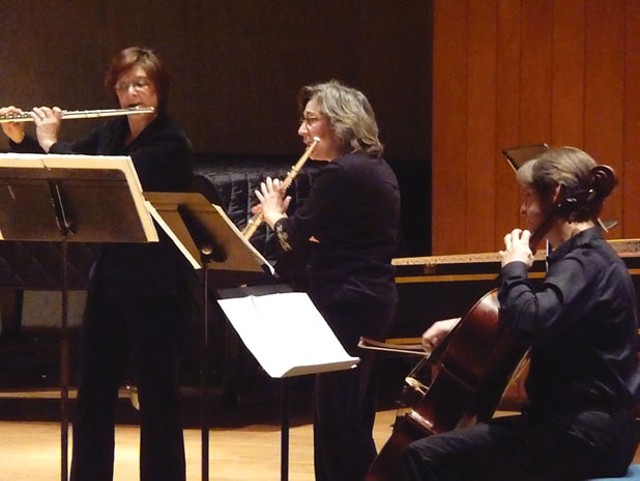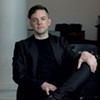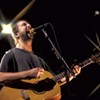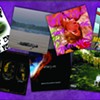Published January 9, 2013 at 11:22 a.m.
The Burlington Chamber Orchestra is redefining “chamber” for its next concert. Founded in 2007 primarily as a strings group, the BCO chose Saturday night’s program to highlight its nine wind-instrument players.
“Winds are always kind of tucked away in the back of the orchestra,” explains Alan Parshley, a horn player with the BCO as well as the Vermont Symphony Orchestra. Parshley is the new head of the BCO musicians’ committee, which selects programming. This concert’s opening piece includes four string players, but otherwise the program features the group’s talented flute, oboe, clarinet, bassoon and horn players.
Paring down the ensemble, Parshley adds, also enables the BCO to stage a full concert in what he calls “these hard economic times.” Indeed, according to flute player Berta Frank, the group recently was “not sure we were going to make it.” Particularly missed is its energetic former musicians’ committee head, violist Ana Ruesink, who recently left for an extended stay in England.
But, says Frank, the group’s “energy” was too “wonderful” for players to let it fold. And, she notes, “We’re Burlington’s only truly local professional orchestra.” (Half the VSO’s players come from out of state.)
Ah, for the old, secure days of royal court patronage — the era, as it happens, that gave birth to the wind ensemble. Haydn and others had written the odd piece for small, all-wind groups in the early 18th century, but when the Austrian emperor Joseph II decided in 1782 that he wanted his dinners accompanied by a wind octet, courts all over Europe started following his lead. To meet the sudden demand for Harmoniemusik, as the new wind-ensemble music was called, composers started to turn out (or approve) wind-only arrangements of their work.
It was a boon for Mozart and others — a way of popularizing their best melodies without needing to drag their patrons to full-scale operas and concerts. Mozart also cleverly lampooned the whole trend in the last act of his 1787 opera Don Giovanni. The Don enjoys his final dinner, before being dragged down to hell, accompanied by a wind ensemble that plays an aria from another Mozart opera, The Magic Flute. “I’ve heard this once too often,” Giovanni grumbles.
Saturday’s audience is less likely to complain when the BCO plays the very same thing: selections from Flute arranged by Mozart’s contemporary, Joseph Heidenreich, for an ensemble made up of pairs of oboes, clarinets, bassoons and horns.
The octet comes in the middle of a neatly numerical program, between a septet by Franz Berwald and a nonet by Charles Gounod.
Gounod is better known for his “Ave Maria” aria than for the Petite Symphonie he wrote in 1885 for wind octet plus flute, to honor his friend, a flautist at the Paris Conservatory. “There’s a lot of different colors in [the piece],” says Frank, who will be playing the solo-like flute part. “[Gounod] really knows how to paint with instruments. A lot of operatic composers don’t know how to do that.”
On the other hand, the Swedish composer Berwald — “not a household name,” Parshley admits — is pretty much only known for his 1828 septet. One reason is the piece’s unusual combination of violin, viola, cello and double bass with three lower-range winds: clarinet, horn and bassoon. The absence of flute and oboe makes for a “mellow, rich, warm, dark sound,” Parshley says.
All three pieces are melodic and accessible, as BCO’s programming typically is. For 21st-century patrons — the audiences — the concert is an easy and fun choice.
No less so for the musicians. Wind ensembles, Frank enthuses, have “so much texture and, what’s the word — I need more nouns in my life! — the word is timbre. Your color palette is a lot more varied. You get to have more fun.”
Burlington Chamber Orchestra winds “7-8-9” concert on Saturday, January 12, 8 p.m. at McCarthy Arts Center at St. Michael’s College in Colchester. $25; $10 students. flynntix.org
The print version of this article was headlined "Blowing It: Wind Players Take Center Stage in an Unusual BCO Concert".
More By This Author
Speaking of...
-

Two Local Band Directors March in the Macy's Parade
Nov 22, 2023 -

Before a Burlington Show, the Wood Brothers Get Back to Basics
Oct 26, 2023 -

After a Half-Century of Leading Local Ensembles, Steven and Kathy Light Prepare a Musical Farewell
May 3, 2023 -

Double E 2023 Summer Concert Series Kicks Off With the Wailers
Mar 17, 2023 -

UVM’s New School of the Arts Gathers Many Creative Disciplines Under One Roof
Sep 14, 2022 - More »
Comments
Comments are closed.
From 2014-2020, Seven Days allowed readers to comment on all stories posted on our website. While we've appreciated the suggestions and insights, right now Seven Days is prioritizing our core mission — producing high-quality, responsible local journalism — over moderating online debates between readers.
To criticize, correct or praise our reporting, please send us a letter to the editor or send us a tip. We’ll check it out and report the results.
Online comments may return when we have better tech tools for managing them. Thanks for reading.














































